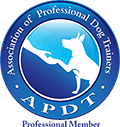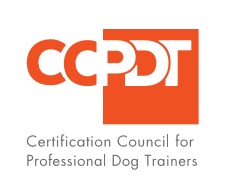Archive CF :: From a Trainer's Notebook
As a dog trainer, I've noticed some fascinating intricacies of dog behavior. They're observations and details that anyone can see -- I have no magic third eye when it comes to dogs -- but somehow, along the way, patterns jump out when you're open and looking for them. I'm sure, when you read them, you'll think to yourself, "Well, of course! Anyone could see that!" and you'd be right! Just about everyone has seen them, and yet how many of us have really put much thought into it?
Little Dogs Get No Respect!
I worked with a client and his toy poodle and I remember watching in sadness as he yanked and dragged the little dog from one place to another with no regard for the dog's autonomy or personal space. That was the day I came by the axiom: All little dog owners should be required to own a big dog first.
Except under the most dire of circumstances, such as when a dog wanders too close to traffic and needs to be pulled abruptly out of harm's way, no one would dream of manhandling a rottie or shepherd the way they might a little lhasa. We invite big dogs to join us, to follow us, to move with us. With little dogs, we force more than we invite.
Let's not marginalize our best friends, no matter how small they might be. If you find that you and your pooch are not like-minded in the ways you spend your time together, that you need to use your leash to keep your dog beside you, then training can teach your dog all of the reasons why being at your side is to his advantage.
Toys are More Fun!
I remember fondly how, when I was a child, my father could make a forkful of broccoli or green beans a more entertaining mouthful by transforming it into a plane coming in for a landing on my tongue-tarmac. What child hasn't fallen for this old chestnut of a parenting trick and enjoyed it despite themselves?!
Well, I've noticed it can work with dogs, too! I've seen more than a few dogs who, though not particularly turned on by their kibble, will suddenly eat with renewed vigor when their food is distributed in a puzzle toy like the Tricky Treat ball (by Omega Paw). My own dog will overlook nuggets of food strewn on the floor and opt instead to toil over her food-stuffed ball, though the food is exactly the same!
The trick is to spend time teaching the dog how to access the food from the toy first, employing particularly tasty treats to jump-start his motivation to work. Once your dog has mastered the toy and is enjoying the challenge, then you can stuff with less valuable tidbits, like his normal kibble.
Variety is the Spice of Life
People underestimate the importance of having a variety of treats when training. Many of my clients will come to a training session with one or two of their dog's favorite treats and think that will get them through. Well, for labs, who as a rule don't have the most discerning palates and can get revved up by just about anything, one or two treats might do the trick. But most dogs max out fairly quickly and need a super-charge part way through a training session to keep them engaged. I usually start out using tidbits of hot dogs and Natural Balance. Then, when the pooch seems to hit a wall, which usually happens when we introduce a new, more difficult behavior, I pull out the big guns -- boiled chicken or cheese! The novel "yum" factor of these can put a spark back into the learning process when it might seem like all is lost.
So the take-away is: Have a treat rotation tor training, and hold back something especially yummy out of this rotation, something that can relight the training fire when it seems to be burning out. Keep in mind that, when training, it's best to use soft, very small treats. Ten tiny treats are ten times better than one big treat in their eyes, and they won't fill up as fast. And soft treats can be chewed and swallowed quickly so you can be on to the next repetition faster.
Little Dogs on High
If you've spent any time at the dog run, you've no doubt noticed the immediate change that takes place when the pet parent of a little dog picks said dog up in her arms. All of the other dogs, large and small alike, start jumping, seeking to get at the little dog. My own dog does this when I pick up one of my cats, and it can even happen when someone holds a baby of the human variety with its little dangling legs. I think it's predatory in nature, as it seems like a strongly hard-wired behavior, but I can't say for sure. I do know, though, that it can be a recipe for disaster should the dog on the ground successfully reach his target. He might well grab hold and drag down, and grave injury can result.
Ultimately it is safest to segregate play groups by size so that small dogs are not in the company of large dogs. Also, in mixed-species households like mine, teach the dog quiet, polite behaviors in the company of the cats, like a calm sit-stay.
Are Two Better than One?
When deciding whether to open your heart and your home to another dog, make sure to consider your current furry family member's perspective. While many will thrive having the company of another, especially if they're left alone for long hours at a time, others prefer being the only pet, either because they're not particularly good players with other animals or because they don't want to share your attention. If this is the case, then your current animal should have the deciding vote; after all, he'll be the one living day in and day out with the newbie. Imagine if someone were to thrust a new housemate on you against your will!
As important as training is with a single dog, it is absolutely critical in a multi-dog household. Training is the best way to assert yourself as leader. So, if you haven't invested the time to train the dog you have, introducing another dog to the family is only inviting a life of pure chaos. Having more pets means more of your time, not less; so, if you are pressed for time with the family you have, be grateful for the love you already share and leave it at that.
The One Constant -- that Everything Changes... even Me!
Perhaps most remarkable are the changes I've seen in myself, especially how I use and express myself physically with dogs. My eyes have always been considered one of my more attractive traits, as they're big and expressive, so for a good part of my life in the world of humans I have accentuated their size and flash. With dogs, though, this is an encumbrance, a challenge and, at the very least, off-putting. The way humans (and primates in general) greet each other -- looking straight at someone, leaning forward, reaching out -- is very assertive to dogs. When polite dogs greet each other, they approach indirectly, avert their gaze, and exchange a sniff.
In my role as a good-will ambassador between dogs and humans, translating the intentions and motivations of each to the other, I myself have become an ever more fluent speaker of doglish, aware of the nuances and suggestions of seemingly innocuous human movements.
So, if despite your best intentions, your dog seems in a quandary about what you're asking of him, it may well be your doglish that is falling short of its mark. Examine your physical expression to your dog and your dog's response to it and then perhaps the twain shall meet!
* The book "The Other End of the Leash" by Patricia McConnell is a great resource for improving human-dog communication.




